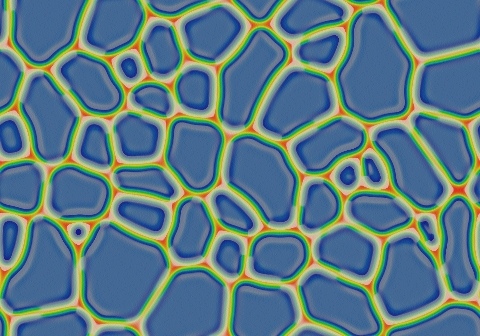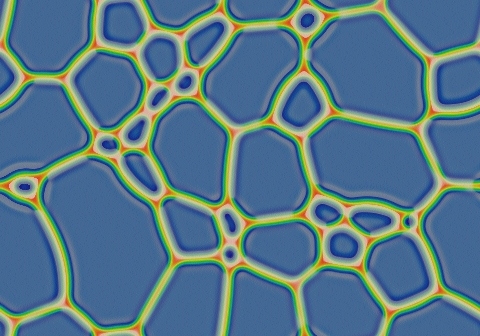Gray-Scott Model at F 0.1060, k 0.0530
These images and movie demonstrate the behavior of the Gray-Scott reaction-diffusion system with σ=Du/Dv=2 and parameters F=0.1060, k=0.0530.
Red spots on a blue background quickly shrink and disappear.
Blue spots on a red background, as seen here, quickly grow to fill the space, but upon meeting one another tend to remain separate. Larger spots tend to overpower smaller spots, and the small spots usually join a neighboring large spot; however they can sometimes survive for an extended period as solitons (for example, two spots in upper-right from 0:09 to 0:20, another in lower-right from 0:17 to 0:30). The overall effect is somewhat like a negative version of the coalescing "bubbles" seen to the east but with less surface tension in the edges.
Categories: Munafo σ; Wolfram 2-a (glossary of terms)
 increase F increase F
 | |||
  |


|
15 frames/sec.; each fr. is 858 iter. steps = 429 tu; 1801 fr. total (772,629 tu) |  increase k 
|

|


| ||

 |
In these images:
- Color indicates level of u, ranging from purple (lowest u values) through blue, aqua, green, yellow and pink/red (highest u values)
- Areas where u is increasing are lightened to a light pastel tone; where u is decreasing the color is vivid.
- In areas where u is changing by less than ±3×10-6 per tu, an intermediate pastel color is seen. This includes areas that are in steady state or equilibrium.
''tu'' is the dimensionless unit of time, and ''lu'' the dimensionless unit of length, implicit in the equations that define the reaction-diffusion model. The grids for these simulations use Δx=1/143 lu and Δt=1/2 tu; the system is 3.2 lu wide. The simulation meets itself at the edges (periodic boundary condition); all images tile seamlessly if used as wallpaper.
Go back to Gray-Scott pattern index
This page was written in the "embarrassingly readable" markup language RHTF, and was last updated on 2019 Jan 05.
 s.11
s.11